Ducks is a popular theme for story time and there are many, many books and stories available. Here are some of my favourites.
Alexander’s Outing by Pamela Allen (1993, Penguin Books) is one of my all time favourite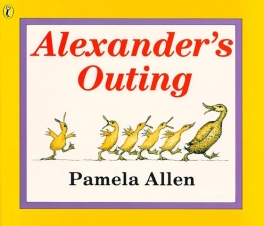 books to read aloud. Alexander, his mother and four siblings set off for a walk. His mother repeatedly reminds them to ‘stay close and take care’, however Alexander does not and he finds himself down a very long hole. Many bystanders try and help him out with an assortment of items, all to no avail. When a small boy comes along he tips his drink down the hole, giving them all a wonderful idea. Together they work to free Alexander.
books to read aloud. Alexander, his mother and four siblings set off for a walk. His mother repeatedly reminds them to ‘stay close and take care’, however Alexander does not and he finds himself down a very long hole. Many bystanders try and help him out with an assortment of items, all to no avail. When a small boy comes along he tips his drink down the hole, giving them all a wonderful idea. Together they work to free Alexander.
Storytelling idea: Using a long vase, or clear tube, drop a rubber duck in and slowly fill with water, watching it rise to the top. Add food colouring so the water is seen by audience members.
Hairy Maclary and Zachary Quack by Lynley Dodd (2014, Puffin Books, first published by 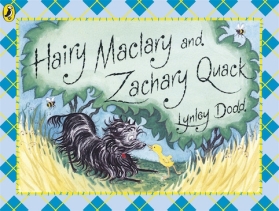 Mallinson Rendel Publishers in 1999) is a fun rhyming read aloud. From the popular series, Hairy Maclary is settling in for a nice afternoon nap when Zachary Quack comes to play. Followed by the insistent duckling wherever he goes, Hairy Maclary decides to jump in the river. He gets stuck and is unable to climb out, but Zachary Quack is there to guide him. They then settle back under the trees for a nap together.
Mallinson Rendel Publishers in 1999) is a fun rhyming read aloud. From the popular series, Hairy Maclary is settling in for a nice afternoon nap when Zachary Quack comes to play. Followed by the insistent duckling wherever he goes, Hairy Maclary decides to jump in the river. He gets stuck and is unable to climb out, but Zachary Quack is there to guide him. They then settle back under the trees for a nap together.
Activity idea: Make a map of the garden the two characters travel through. This can be incorporated during story time while reading, or young school children can draw the map after listening to the book.
It’s Useful to Have a Duck by Isol (2009, Allen and Unwin), is a wonderful 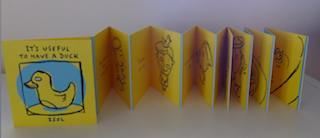 introduction to the concept of the narrator. It is a concertina board book that has two different titles and two different ways of reading. Both use the same pictures, but are narrated by the boy or the duck. The boy’s viewpoint discusses all the uses for a duck while the duck’s discusses all the uses for a boy. The verbal text is on the left hand side while the visual text is on the right. Two colours are used, light blue and yellow, and they alternate for each different viewpoint. When one side is read, it ends on the title page of the alternate reading, ingenious! It’s useful to have a duck lists all the uses for a duck, including a hat, whistle, nose, and to help dry off. This is a short read and would suit the younger ones in a story time audience.
introduction to the concept of the narrator. It is a concertina board book that has two different titles and two different ways of reading. Both use the same pictures, but are narrated by the boy or the duck. The boy’s viewpoint discusses all the uses for a duck while the duck’s discusses all the uses for a boy. The verbal text is on the left hand side while the visual text is on the right. Two colours are used, light blue and yellow, and they alternate for each different viewpoint. When one side is read, it ends on the title page of the alternate reading, ingenious! It’s useful to have a duck lists all the uses for a duck, including a hat, whistle, nose, and to help dry off. This is a short read and would suit the younger ones in a story time audience.
Activity idea: Make a concertina book with own uses for a duck, or other animal.
D is for DuckI by David Melling (2016, Hodder Children’s Books) is a fun alphabet book with 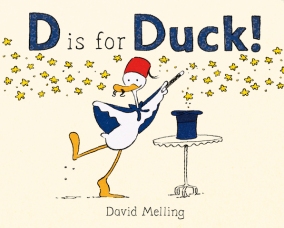 a difference. Duck is a magician and conjures his way through the alphabet. The only written text is the word for each letter, from A to Z, however there is a lot happening in the visual text to tie everything in beautifully. Full colour double page spread at eye level enables the reader to feel like they are part of the audience. The expressions on the faces of the animals, especially duck, are great and really add to the visual storytelling. The ending is unexpected and introduces young readers to word play. This book requires input from the storyteller and audience while reading, ensuring a different experience each time.
a difference. Duck is a magician and conjures his way through the alphabet. The only written text is the word for each letter, from A to Z, however there is a lot happening in the visual text to tie everything in beautifully. Full colour double page spread at eye level enables the reader to feel like they are part of the audience. The expressions on the faces of the animals, especially duck, are great and really add to the visual storytelling. The ending is unexpected and introduces young readers to word play. This book requires input from the storyteller and audience while reading, ensuring a different experience each time.
Duck in the Truck is from Jez Alborough’s wonderful duck series of picture books. These 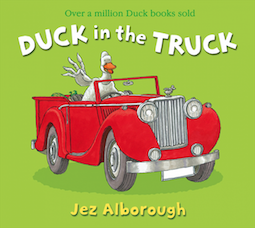 books are a hit at any story time session. In this title, Duck is driving home when his truck becomes stuck in the mud. Frog comes to help, then sheep, but they are unable to push it out. Finally Goat comes along in his boat and offers a solution that relieves Duck’s truck of the mud, but find the other three characters stuck. The large format of this book lends itself beautifully to story time, and the language is lots of fun, with rhyming, onomatopoeia and descriptive language. The panels provide an excellent introduction to story sequencing and slows the reading nicely. Young audiences can join in with actions and noises.
books are a hit at any story time session. In this title, Duck is driving home when his truck becomes stuck in the mud. Frog comes to help, then sheep, but they are unable to push it out. Finally Goat comes along in his boat and offers a solution that relieves Duck’s truck of the mud, but find the other three characters stuck. The large format of this book lends itself beautifully to story time, and the language is lots of fun, with rhyming, onomatopoeia and descriptive language. The panels provide an excellent introduction to story sequencing and slows the reading nicely. Young audiences can join in with actions and noises.
Ben and Duck by Sara Acton (2011, Scholastic Australia) When Ben goes to feed the ducks at the park there is only one, a very large duck. This duck follows Ben as he goes home. They share dinner and a bath, and when it is time for bed they say goodbye until another day. This is a beautifully soft story of an unlikely friendship and a perfect read aloud.
Ducks Away! By Mem Fox, illustrated by Judy Horacek (2016, Scholastic Australia) A mother duck waddles onto a bridge, followed by five fluffy ducks. One of the ducklings falls into the water, sending Mother duck into a panic, what should she do with four ducklings on the bridge and one in the water? As she is pondering this, another falls in, and so on until all ducks are now in the water below. There is only one thing for mother duck to do. This is a simple story with repetitive rhyme, perfect for young children. The full page, uncluttered illustrations a clearly defined with bright colours and black outlines.
Variation idea: This story could be easily told using rubber ducks over a clear bowl, or as a felt board story. A combination of the book and the bowl would link actions to story.
Listen to Mem Fox reading her story.
Resources for a ducky storytime
This is possibly the easiest storytime theme to resource. Ducks feature in many cultures  and you will see many variations for sale everywhere. In this image there are wooden, felt and rubber ducks. I have bought these in various locations, including garage sales, a tourist’s shop in Korea, bargain shops, and the felt ducks at a craft market.
and you will see many variations for sale everywhere. In this image there are wooden, felt and rubber ducks. I have bought these in various locations, including garage sales, a tourist’s shop in Korea, bargain shops, and the felt ducks at a craft market.
The Little Big Book Club has a fun craft activity.
A variety of duck templates and suggestions for their use can be found at DLTK’s nursery rhymes: Five Little Ducks Felt Board Printables page. These can be used to make your own felt board stories, or have the children make their own rhymes.
The featured image of rubber ducks is by gaetanlee (http://www.flickr.com/photos/gaetanlee/298160434/) [CC BY 2.0 (http://creativecommons.org/licenses/by/2.0)%5D, via Wikimedia Commons

These are great – Thanks for the suggestions! I’m reading Duck in the Truck this Thursday and also Farmer Duck. Going to look at your other suggestions too!
LikeLike
Thanks for your comment, I am pleased you like them.
LikeLiked by 1 person